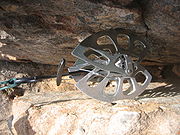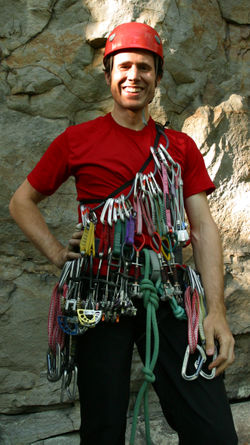
Spring loaded camming device
Encyclopedia


Rock climbing
Rock climbing also lightly called 'The Gravity Game', is a sport in which participants climb up, down or across natural rock formations or artificial rock walls. The goal is to reach the summit of a formation or the endpoint of a pre-defined route without falling...
or mountaineering
Mountaineering
Mountaineering or mountain climbing is the sport, hobby or profession of hiking, skiing, and climbing mountains. While mountaineering began as attempts to reach the highest point of unclimbed mountains it has branched into specialisations that address different aspects of the mountain and consists...
protection
Protection (climbing)
To make climbing as safe as possible, most climbers use protection, a term used to describe the equipment used to prevent injury to themselves and others.-Types of climbing:...
equipment
Climbing equipment
A wide range of equipment is used during rock climbing. The most popular types of climbing equipment are briefly described in this article. The article on protecting a climb describes equipment commonly used to protect a climber against the consequences of a fall....
. It consists of three or four cam
Cam
A cam is a rotating or sliding piece in a mechanical linkage used especially in transforming rotary motion into linear motion or vice-versa. It is often a part of a rotating wheel or shaft that strikes a lever at one or more points on its circular path...
s mounted on a common axle or two adjacent axles, so that pulling on the axle forces the cams to spread farther apart. The SLCD is used by pulling on the "trigger" (a small handle) so the cams move together, then inserting it into a crack or pocket in the rock and releasing the trigger to allow the cams to expand. At this point the climbing rope can be attached to a sling
Sling (climbing equipment)
A sling or runner is an item of climbing equipment consisting of a tied or sewn loop of webbing that can be wrapped around sections of rock, hitched to other pieces of equipment or tied directly to a tensioned line using a prusik knot; for anchor extension , equalization, or climbing the...
and carabiner
Carabiner
A carabiner or karabiner is a metal loop with a sprung or screwed gate that is used to quickly and reversibly connect components in safety-critical systems. The word comes from "Karabinerhaken", meaning "hook for a carbine" in German.-Use:...
at the end of the stem. A pull on the rope, such as that generated by a climber falling, will cause a properly placed SLCD to convert the pulling force along the stem of the unit into outwards pressure on the rock, generating massive amounts of friction and preventing the removal of the unit from the rock. Because of the large forces which are exerted on the rock when an SLCD is fallen on, it is very important that SLCDs are only placed in solid, strong rock.
History
Vitaly AbalakovVitaly Mikhaylovich Abalakov
Vitaly Mikhaylovich Abalakov was a Soviet/Russian mountaineer and inventor.Brother of Yevgeniy Abalakov, another famous alpinist, he made the first Soviet ascent of Lenin Peak in 1934 and two more ascents of this mountain. In 1936 he also made the ascent of Khan Tengri.In 1938, he and others from...
's invention of the Abalakov Cam was the first application to climbing of the principle of a constant-angle curved surface, with a cam shape based on the mathematical logarithmic spiral
Logarithmic spiral
A logarithmic spiral, equiangular spiral or growth spiral is a special kind of spiral curve which often appears in nature. The logarithmic spiral was first described by Descartes and later extensively investigated by Jacob Bernoulli, who called it Spira mirabilis, "the marvelous...
. Using a logarithmic spiral shape results in a constant angle between the cam and the rock at each contact point; this constant angle is designed to always provide the necessary friction to hold a cam in equilibrium. Designed so that a load produces a rotational force, the logarithmic cam shape allowed for a single device to fit in a range of crack sizes without a change in the loading pattern, making it predictable and stable.
In 1973 Greg Lowe filed for a patent for a spring-loaded version of the Abalakov Cam.
Modern SLCDs were invented by Ray Jardine
Ray Jardine
Ray Jardine is an American rock climber who, with Bill Price, in May 1979, was the first to free climb the West Face of El Capitan in Yosemite Valley...
in 1978 (US patent 4,184,657) and sold under the brand name of "Friends". Ray designed a spring-loaded opposing multiple cam unit with a more stable 13.75 degree camming angle and an innovative triggering mechanism. ("Friend" is now widely used by climbers to refer to SLCDs in general, but properly speaking it refers to the brand now manufactured by Wild Country
Wild Country (company)
Wild Country is a major manufacturer of rock climbing equipment, and is most noted for introducing the Friend, a spring-loaded camming device...
.) Other popular brands include Black Diamond Camalot
Camalot
Camalot is a brand of spring-loaded camming devices, manufactured by Black Diamond Equipment, Ltd.The device is used to secure ropes while rock climbing.There are two types of Camalots, 4-lobed C4s and 3-lobed C3s...
s, Metolius Power Cams, DMM 4CUs, Trango FlexCams, and CCH Aliens.
Modern use
The invention of SLCDs revolutionized rock climbing because it meant that parallel or flared cracks could be protected. Furthermore, unlike pitonPiton
In climbing, a piton is a metal spike that is driven into a crack or seam in the rock with a hammer, and which acts as an anchor to protect the climber against the consequences of a fall, or to assist progress in aid climbing...
s, SLCDs can be removed easily without causing damage to the rock, which made clean climbing
Clean climbing
Clean climbing is a rock climbing term that describes techniques and equipment which climbers use in order to avoid damage to the rock. These techniques date at least in part from the 1920s and earlier in England, but the term itself may have emerged in about 1970 during the widespread and rapid...
(climbing without damaging the rock) practical on many more climbs. Since the invention of the Technical Friend (which replaces the original one-piece machined
Machining
Conventional machining is a form of subtractive manufacturing, in which a collection of material-working processes utilizing power-driven machine tools, such as saws, lathes, milling machines, and drill presses, are used with a sharp cutting tool to physical remove material to achieve a desired...
alloy shaft with a brazed
Brazing
Brazing is a metal-joining process whereby a filler metal is heated above and distributed between two or more close-fitting parts by capillary action. The filler metal is brought slightly above its melting temperature while protected by a suitable atmosphere, usually a flux...
assembly incorporating a length of thick stainless-steel cable, which is better able to cope with loading over an edge), there has been a great deal of development of the SLCD by a variety of manufacturers. For example, the adoption of the dual axle design by Black Diamond, the invention of three-lobed camming units to fit smaller cracks, and the more recent invention of the Link Cam by Omega Pacific, a design that allows one SLCD to span an even larger range of crack sizes. Behind the store display rack work done by companies such as Metolius Climbing help to keep cams safe in the market place and apply technical advances in their designs. SLCDs are sold in various sizes to fit a diverse range of cracks from about 6 mm to 300 mm wide, though devices of below about 10mm or above about 100 mm are not often seen.
Modern trad climbers often climb with numerous and variously sized SLCDs to cover a wide range of crack sizes, sometimes with duplicate units depending on protection requirements of the climb. Some crag climbs, such as those in Indian Creek
Indian Creek
-Communities:* Indian Creek, California, unincorporated community in Calaveras County* Indian Creek, Florida, village in Miami-Dade County* Indian Creek, Illinois, village in Lake County* Indian Creek No...
, require numerous pieces of the same size as the crack maintains about the same size for the whole climb.
Engineering
For the purposes of this article, =force of friction,
=force of friction,  =normal force,
=normal force,  =gravitational force in the case of a static force applied to the cam or applied force in the case of a fall, r=radius,
=gravitational force in the case of a static force applied to the cam or applied force in the case of a fall, r=radius,  =camming angle,
=camming angle,  =coefficient of friction between the SLCD and the rock,
=coefficient of friction between the SLCD and the rock,  =r(0)=smallest radius of the camming lobe, C=a constant. We'll start by modeling the cam lobe as a 2-dimensional invincible bar of varying length r.
=r(0)=smallest radius of the camming lobe, C=a constant. We'll start by modeling the cam lobe as a 2-dimensional invincible bar of varying length r.We need to find the relationship between the coefficient of friction and the angle. We'll do this by setting forces equal and such.






We also need to derive the spiral shape of the cam lobe keeping in mind that we want to maintain the same value of
 as the rock wall gets further from the cam at the point of contact. Note that for this derivation, it does not matter whether the crack is closing, parallel, or flaring because we are only paying attention to the one point at which the cam comes in contact with the rock, which can only be further from or closer to the cam center. In order to derive the spiral, we will express the relationship between
as the rock wall gets further from the cam at the point of contact. Note that for this derivation, it does not matter whether the crack is closing, parallel, or flaring because we are only paying attention to the one point at which the cam comes in contact with the rock, which can only be further from or closer to the cam center. In order to derive the spiral, we will express the relationship between  and infinitesimal movements of the contact point.
and infinitesimal movements of the contact point.








C=r(0)

But
 cannot be less than
cannot be less than  by the definition of
by the definition of  since we do not have negative
since we do not have negative  values in this case, so
values in this case, so
Note the graph of the spiral below from an angle of 0 to pi.

